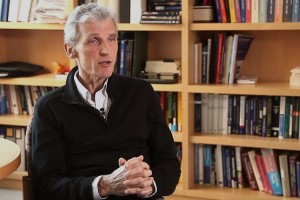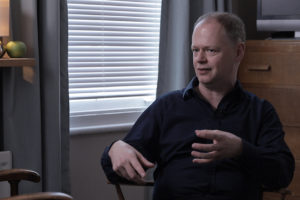Quantum Simulation
Nobel Prize-winning physicist Wolfgang Ketterle on simulating superfluidity, 'atomic Legos', and a special-pur...
ATLAS is a name for two things which are in some ways distinct. One is that it’s the name for a particle detector on the Large Hadron Collider, which I’ll say a little bit more about in a minute. The other is that it’s the name for a huge international collaboration of particle physicists, more than three thousand of us from all over the world, who built that detector, who run it now, collect data with it and analyze that data and publish papers about physics based on the results from ATLAS. So, people refer to the ATLAS collaboration and the ATLAS detector.
We should start with the ATLAS detector, which is probably the most interesting thing. The Large Hadron Collider is this 27-kilometre tunnel in the Geneva region of Switzerland on the border with France, underground. What the Large Hadron Collider does is it contains the two highest energy beams of particles that we’ve ever managed to focus and steer and create in the laboratory. We bring them into a head-on collision with each other in four separate places on the ring. In each of those places, the idea is that when these protons collide at such high energies, then it’s giving us access to physics at the highest energies, which also actually means the shortest distances.
So you can think of it as the most powerful microscope that we’ve ever built because we’re studying the structure of matter at the smallest distances that humanity has ever been able to probe.
So, the information from that short-distance physics, from that structure of matter, is contained in the products. When these protons collide, they fly everywhere, and the only way we can work out what’s going on at short distances is to detect what’s produced in the collisions and then interrogate it. So we use mathematical, physical ideas about the laws of physics and mathematical techniques, and, crucially, the detector. Without the detector, we know nothing. You can think of the ATLAS detector as the most sophisticated, highest-resolution digital camera that we’ve ever built. We’re photographing what’s going on inside these proton-proton collisions.
There are three other big detectors on the Large Hadron Collider. One of them is called CMS, which is on the opposite side of the ring. It is doing very similar things to ATLAS but with different kinds of technology. Then there’s another one called LHCb and another one called ALICE, which are more specialized. ATLAS and CMS essentially look quite similar in some ways. The basis of the detector is that you have the beam pipe in the middle, so they’re like cylinders with the beam pipe in the middle, and the collisions happen in the middle. Most of the protons actually miss; they go straight through, but some of them collide, and those are the ones we’re interested in. We surround the collision point first of all with detectors that detect charged particles.
The best way we have at the moment of detecting a charged particle is to build a semiconductor detector, usually out of silicon. What a semiconductor is, as the name suggests, it is almost the conductor of electricity, so it has electrons that are not free, so they don’t carry a current. But if you give them a tiny little kick, they can escape into an energy band, which means they can move freely around the material. The idea is that when one of our particles flies by, it gives them this little kick, and it’s a tiny little kick, so the particle doesn’t change direction; it carries on going the way that we want to measure. But the fact that one of the electrons has been freed means you can accelerate it away with a voltage and tell that the particle went past. So you get very precise points on the particle tracks, and that allows you to work out that this particle came here and there and where it’ll go.
So, outside of the tracking, we have then what we call calorimeters. All the particles basically stop in the calorimeter apart from two kinds of particles, which I’ll tell you about in a minute: all the others stop in the calorimeter. And when they stop, they decelerate; they give off light and electrical fields as they decelerate. We can read that and tell the energy of all of them, not just the charged particles but the neutral ones as well.
There are two particles that escape the calorimeter that punches right through it. One of them is called a muon. A muon is a bit like an electron, but it’s heavier. So we see the muons in the charged particle detector, but then they punch through the calorimeter, and then we have more tracking detectors outside to detect the muons so we can tell the muon was there.
And then the final particle which we just cannot see at all is called a neutrino. They do interact with matter but very very rarely, so if we create one, the chances of interacting are billions to one. So the only way we can tell whether a neutrino was there or not is that we sum up all the other particles, and we’ll see there’s some missing energy or momentum. And then we can guess that that might be a neutrino although it could, of course, be something else like dark matter or something that we don’t know about.
So that’s the ATLAS detector: it produces data on these collisions, and that data is shared all around the world on a computing grid to the ATLAS collaboration, which I mentioned earlier. These thousands of physicists and PhD students, some of whom are next door there, who are looking at this: PhD students, postdocs, professors all over the world who are looking at this data and trying to work out from that what is going on really in the heart of the proton, in the heart of the structure of matter.
Concerning my current research, we’ve just published a paper on measuring the number of times you get four charged leptons produced in these events: four charged leptons are quite unusual, and they’re very high energy, and that has a lot of physics in it. Some of it is from a particle called the Z-boson, and some of it is from two Z-bosons which are the carriers of the weak force. And some of it is from when a Higgs boson is produced, and you get these four leptons. So you have a really intricate structure in how these four leptons can be produced, and by just measuring that as precisely as we can with the ATLAS detector, we can learn a lot about the fundamental physics that’s going on in here, including about the Higgs but also about other things too.

Nobel Prize-winning physicist Wolfgang Ketterle on simulating superfluidity, 'atomic Legos', and a special-pur...

Linguist David Adger on the Facebook chatbots experiment, the history of getting the AI to understand and spea...

Climatologist Thomas Stocker on climate simulations, reaching limits of adaptation, and the 'business as usual...